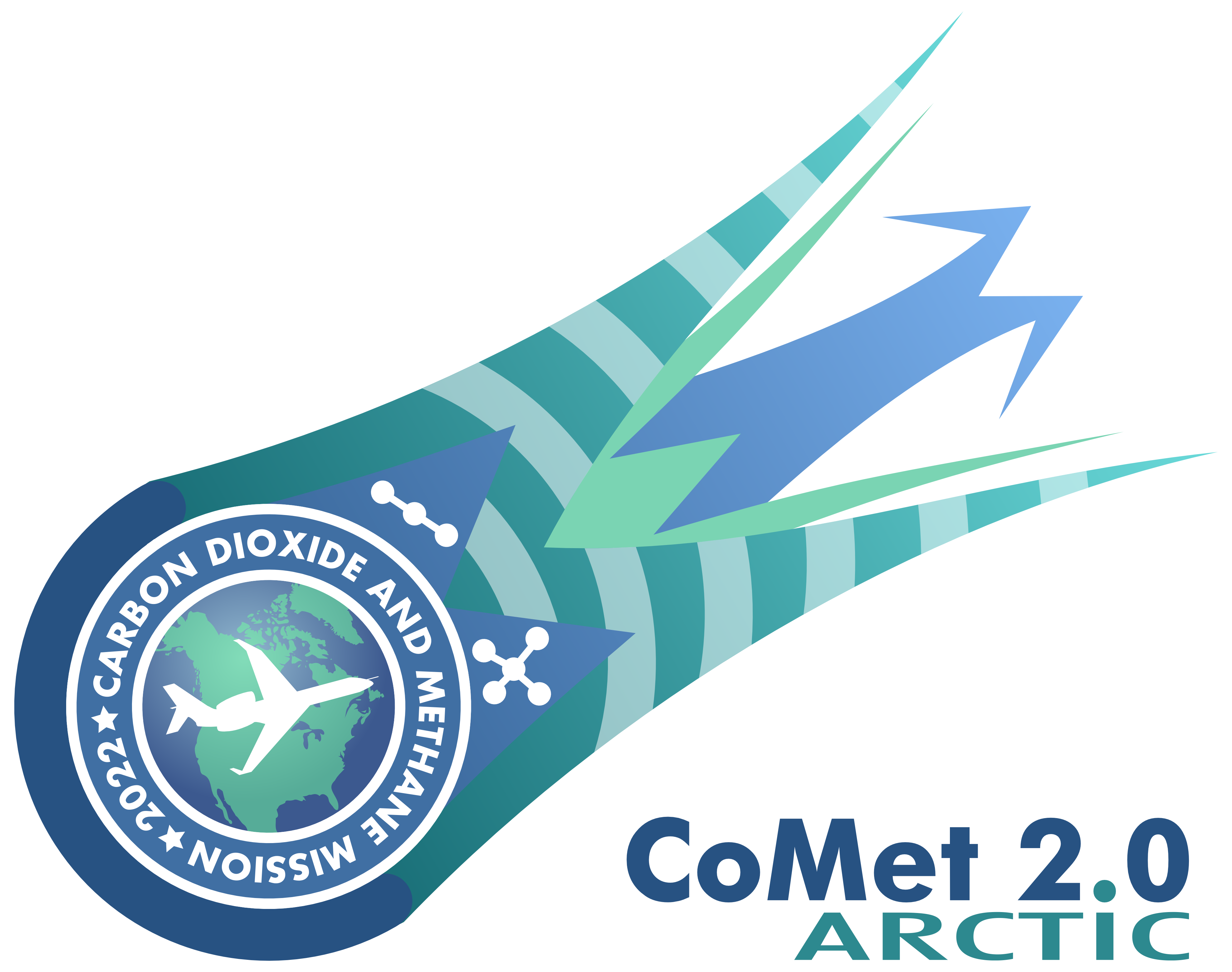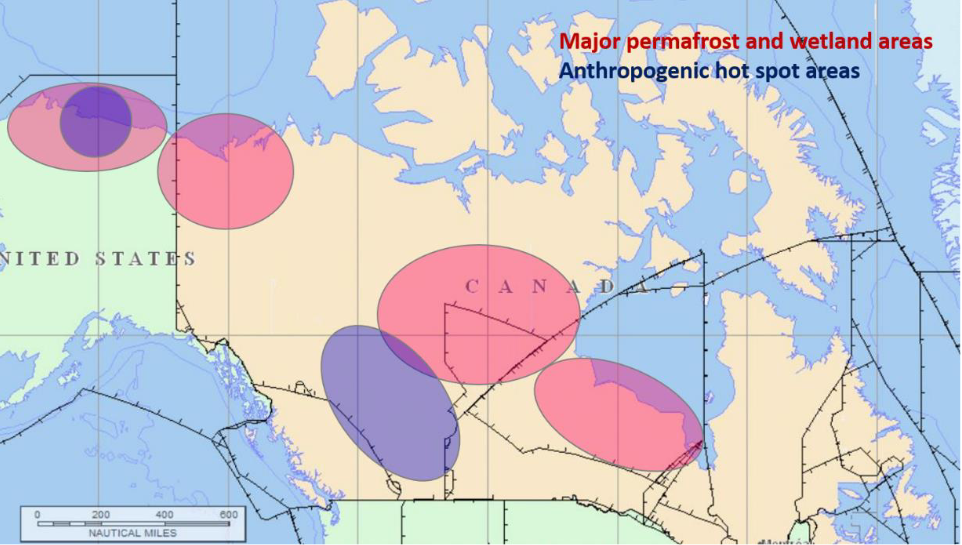
Mission status: Completed
Office phone:
+49 (0)8153 28-2538
June – September 2022
| Mission phase | Dates |
|---|---|
| Preparation, payload integration, EMI testing | Jun - Aug 2022 |
| Mission execution | 06 Aug - 16 Sep 2022 |
| Dismounting of payload | 19 - 23 Sep 2022 |
CoMet 2.0 Arctic aims to learn more about the distribution and temporal variation of the two most important anthropogenically–influenced greenhouse gases, carbon dioxide (CO2) and methane (CH4) in the Arctic. Aircraft–based instruments using both remote sensing and in–situ techniques will carry out measurements of these trace gases and tracers related to their emissions. The results will help to better understand the global methane and carbon cycle. This mission makes use of the German research aircraft HALO.
CoMet 2.0 Arctic is the follow-up campaign from CoMet, which took place in 2018. This campaign took place in Europe and targeted compact emission-sources of CO2 and CH4 like coal mines, coal-burning power plants or landfills. With the expericenes gained from this campaign, we target now emission-sources with much weaker gradients, like boreal wetlands and permafrost araes, but also anthropogenic hot spots in the Alaskan and Canadian Arctic.

For the CoMet 2.0 mission, HALO will be equipped with a suite of sophisticated instruments measuring the carbon dioxide and methane columns between the aircraft and the ground using remote sensing, as well as in–situ instruments that collect air samples at flight level. Furthermore, instruments to provide detailed information about the standard meteorological parameters (pressure, wind, humidity) will also be on board. In order to link those in–flight data to profiles,
the launch of small meteorological sondes is foreseen. The payload is exclusively dedicated to atmospheric measurement.
The payload of the COMET mission will be extended with the integration of the new MAMAP2D instrument. This 2-dimensional imaging spectrometer system measures CO2 and CH4. It is the successor instrument of MAMAP which was flown on the Cessna 207 during COMET. Including these measurements on the same platform with the other remote sensing (CHARM-F, mini-DOAS) and in situ (JIG, JAS) instruments facilitates further synergies for data analysis. Furthermore, the core payload will be complemented by a quantum cascade laser spectrometer to measure ethane (C2H6), a tracer for emissions from oil and gas emissions.
The following table gives an overview on the instruments onboard the aircraft during CoMet and their measurement parameters:
| Scientific instrument acronym | Description | Principal investigator | Institution |
|---|---|---|---|
| CHARM-F | Integrated path differential absorption lidar (IPDA) | Andreas Fix | DLR-IPA |
| MAMAP | Imaging NIR Spectrometer | Heinrich Bovensmann | Univ. Bremen |
| Mini-DOAS | UV/VIS/NIR Spectrometer | Klaus Pfeilsticker | Univ. Heidelberg |
| JIG | Cavity-Ringdown Spectroscopy (CRDS) | Christoph Gerbig | MPI-BGC |
| JAS | Air sampler | Christoph Gerbig | MPI-BGC |
| MIRACLE | Laser Spectrometer | Anke Roiger | DLR-IPA |
| specMACS | Hyperspectral Imaging | Florian Ewald | DLR-IPA |
| BAHAMAS | Basic aircraft measurement system | Andreas Giez | DLR-FX |
| Dropsondes | Meteorological dropsondes | Stefan Kaufmann | DLR-IPA |
| FOKAL | Frequency Comb | Andreas Fix | DLR-IPA |
| Aircraft registration | Date | Take off - Landing / UT | Total flight time / h | From - To | Flight number # |
|---|---|---|---|---|---|
| D-ADLR | 2022-07-22 | 10:06 - 13:05 | 3.22 | EDMO-EDMO | RF00 |
| D-ADLR | 2022-08-04 | 09:04 - 15:48 | 7.02 | EDMO-EDMO | RF01 |
| D-ADLR | 2022-08-06 | 13:02 - 22:28 | 9.72 | EDMO-CYEG | RF02 |
| D-ADLR | 2022-08-09 | 16:04 - 22:27 | 6.62 | CYEG-CYEG | RF03 |
| D-ADLR | 2022-08-10 | 16:04 - 21:48 | 5.98 | CYEG-CYEG | RF04 |
| D-ADLR | 2022-08-12 2022-08-13 | 16:13 - 23:46 01:05 - 03:41 | 7.70 2.88 | CYEG-CYEV CYEV-CYEG | RF05 |
| D-ADLR | 2022-08-16 2022-08-17 | 15:34 - 20:53 00:40 - 02:16 | 5.53 1.80 | CYEG-CYZF CYZF-CYEG | RF06 |
| D-ADLR | 2022-08-18 | 15:27 - 23:41 | 8.42 | CYEG-CYEG | RF07 |
| D-ADLR | 2022-08-25 | 16:57 - 23:15 | 6.53 | CYEG-CYEG | RF08 |
| D-ADLR | 2022-08-26 | 15:07 - 00:07 | 9.20 | CYEG-CYEG | RF09 |
| D-ADLR | 2022-09-02 | 16:34 - 23:51 | 7.52 | CYEG-CYEG | RF10 |
| D-ADLR | 2022-09-03 | 14:59 - 00:43 | 9.97 | CYEG-CYEG | RF11 |
| D-ADLR | 2022-09-05 | 13:27 - 23:41 | 10.43 | CYEG-CYEG | RF12 |
| D-ADLR | 2022-09-07 | 13:28 - 22:31 | 9.25 | CYEG-CYEG | RF13 |
| D-ADLR | 2022-09-10 | 16:53 - 22:20 | 5.67 | CYEG-CYEG | RF14 |
| D-ADLR | 2022-09-11 | 12:57 - 22:34 | 9.82 | CYEG-CYEG | RF15 |
| D-ADLR | 2022-09-14 | 08:54 - 12:12 | 3.52 | CYEG-CYEG | RF16 |
| D-ADLR | 2022-09-16 | CYEG-EDMO | RF17 |